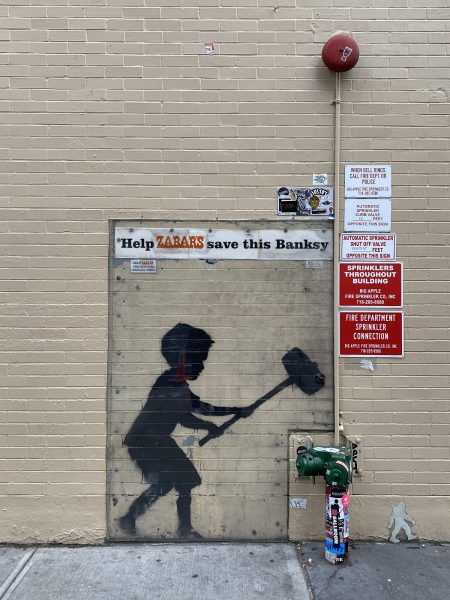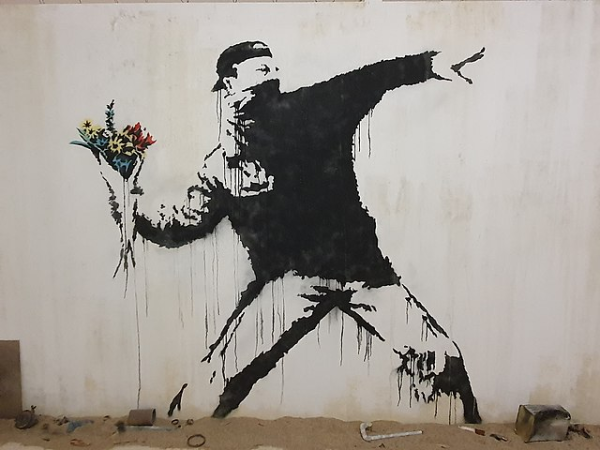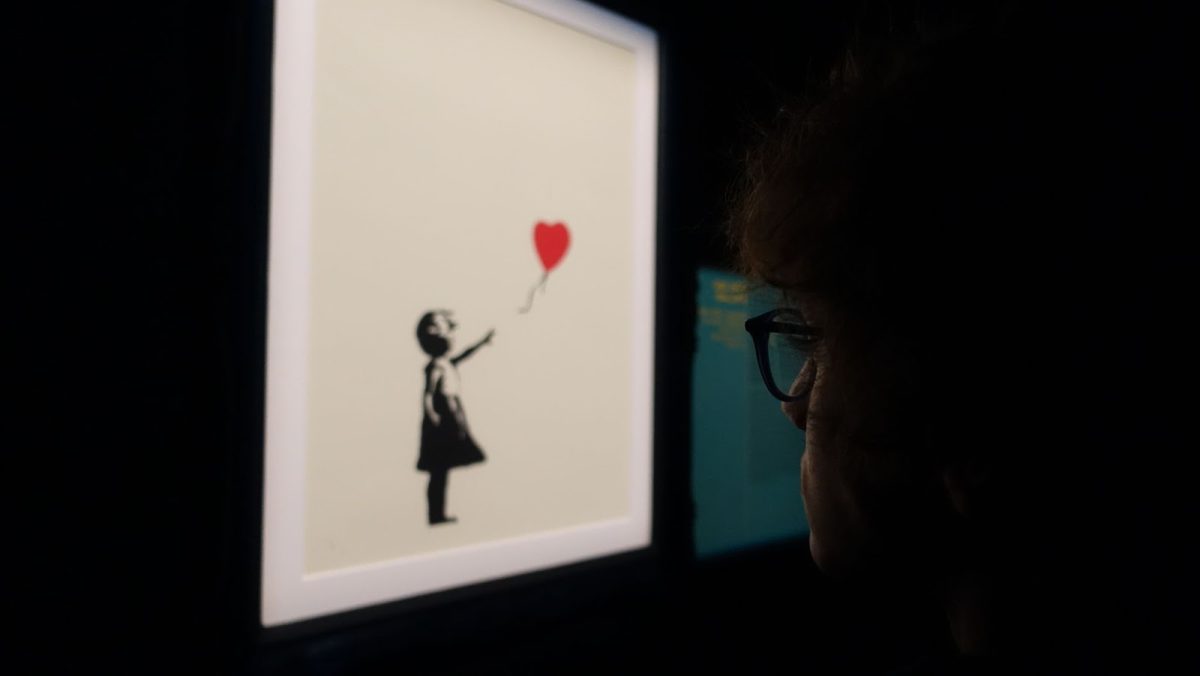In the 1980s, Barton Hill district of Bristol was a tough part of town. The town was predominantly white, working-class, deserted, and unwelcoming to strangers. So when Banksy, who came from the upper part of town, decided to make his first foray there, he was feeling nervous. “My dad was badly beaten up there as a kid,” he told fellow graffiti artist and author Felix Braun. He was trying out different tags, or names, at the time; sometimes signing himself Robin Banx, which eventually turned into what we are now familiar with – Banksy. The shortened version of his signature may have represented less of the “robbing banks” cachet, but it was more memorable and easier to write on wall.
Around this time, he settled on his distinctive stencil approach to graffiti. His earliest works were typically straightforward and concise; they consisted of black-and-white stenciled images that could be copied quickly and drawn all over the city. Though simpler than his later works, Banksy’s early pieces nonetheless conveyed his message and ideals through symbolism and hidden significance.
When he was 18, he was painting a train with a gang of mates when the British Transport Police showed up and everyone ran.
“The rest of my mates made it to the car,” Banksy recalled, “and disappeared, so I spent over an hour hidden under a dumper truck with engine oil leaking all over me. As I lay there listening to the cops on the tracks, I realized I had to cut my painting time in half or give it up altogether. I was staring straight up at the stenciled plate on the bottom of the fuel tank when I realized I could just copy that style and make each letter three feet high.”
But he also told his friend, author Tristan Manco, “As soon as I cut my first stencil I could feel the power there. I also like the political edge. All graffiti is low-level dissent, but stencils have an extra history. They’ve been used to start revolutions and to stop wars.”
On a simple, beige brick wall in the heart of the Upper West Side, there lies one of Banksy’s traces in the world entitled ‘Hammer Boy.’
Banksy completed the piece on October 24th, 2013, and it is the one and only artwork of his that remains in New York City today. This classic graffiti is covered in a thin glass wall, preserving the beautiful piece for over ten years.

Banksy never explained the intended meaning behind this work, so everything is left for pure speculation. The interesting part about this piece is that it shows that some of Banksy’s works may not have a meaning at all but only solve the purpose of aesthetics.
In this piece, a boy is holding up a hammer, similar to something you would see in a high-striker carnival game. As soon as you notice the resemblance, the pole extending upwards from the fire extinguisher becomes a part of the carnival game, where the different point levels are “Fire Department Sprinkler Connection” and “Sprinklers Throughout The Building.” It seems that Banksy intended to take something ordinary and mundane and make it light up, creating a bright and unique atmosphere for the dim, dark city.
Banksy’s art and commentary on political and social concerns grew increasingly nuanced and influential as his career proceeded. From war and conflict to consumer culture and the environment, Banksy’s artworks have challenged and inspired people all around the world.
‘Napalm’ is Banksy’s most dreadful and confrontational work; the combination of symbols of contemporary capitalism and cultural fantasy places this painting alongside the agitprop tradition of the Adbusters magazine. Pop icons were frequently used by artists to express provocative or satirical remarks, and the blend of seeming innocence and sheer terror is what gives ‘Napalm’ its charge.
It’s also what sets Banksy apart from an artist like KAWS, who also incorporates kid-friendly figures like Elmo or Spongebob Squarepants in his work. An older generation of collectors, said Doyle, buy KAWS to “look cool to their kids. But it’s still Sesame Street — they don’t really get it. Whereas Banksy’s an interventionist. It’s political, it looks like political campaigning.”
Banksy first executed his work, ‘Love is in the Air’ in Jerusalem in 2003, painting it on the city’s West Bank barrier wall that separates Israel from its Occupied Territories. The image – which has been endlessly reproduced since – depicts a protestor, sometimes referred to as “the masked thug,” caught in the act of throwing a bouquet of colorful flowers, instead of Molotov cocktails that are caught in flames. This work could also be considered as a contemporary update on the classic 1967 photo ‘Flower Power,’ in which protestors stuffed tiny flowers into soldiers’ gun barrels. This is one of many artworks that Banksy has executed in favor of Palestinian rights, and his advocacy continues to stir controversy. His work re-emerged from the public due to the recent Israel-Hamas War and was used to show support for Palestine.

When talking about Banksy, there is one artwork that always follows him: ‘Girl with Balloon.’ Originally stenciled on an East London wall, this now-iconic figure has been reproduced in many different places, making it one of Banksy’s best-known artworks. The drawing is simple, depicting a girl reaching up towards a red, heart-shaped balloon. There are many interpretations of this drawing – some see it as the girl losing her grasp of the balloon, while others view her as on the verge of catching it, representing hope and freedom.
But what made this specific piece so…iconic?
It all started in 2018 when a 2006 framed copy of the artwork was sold at auction at Sotheby’s.
Many shouted their bids to buy this phenomenal piece of Banksy’s, but finally, one bidder was left.
And in what can be called a quintessential Banksy moment, the moment the auctioneer’s gavel slammed down, selling ‘Girl with Balloon’ for $1.4 million.
The work of art started to lower itself through a shredder built into the bottom of the frame.
The bottom half of the painting was cut into strips, but it stopped shredding in time for the heart-shaped balloon to remain visible. As stunned auction-goers looked on and could barely believe what was happening, the moment became “instant art world history.”
The whole contemporary art world was astonished. As stated by Sotheby’s after the fact, this was “the first work in history ever created during a live auction.” Initially, people wondered whether Sotheby’s was a part of the elaborate prank, but Banksy confirmed in an Instagram post that this was not the case, writing: “Some people think it didn’t really shred. It did. Some people think the auction house were in on it, they weren’t.”
This performance can be considered the real artwork that Banksy wanted to show to his audience. The shred blurred the lines between creation and destruction, between the artist’s intent and the audience‘s experience, effectively redefining what constitutes ‘art’ in the modern day.
Moreover, this served to rebuke the concept of empty consumerism in society by criticizing the capitalistic system that is dictating our lives. As Banksy writes in his book, Wall and Peace, “We can’t do anything to change the world until capitalism crumbles. In the meantime we should all go shopping to console ourselves.” Capitalism and consumerism are common themes Banksy explores in his art. The fact that the shredded piece sold for $25.4 million, about 25 times more than the original price, highlights his idea – finalizing the true meaning behind his art.
Banksy’s artworks are truly beautiful as they have made such great changes in the world. His art is rich with allegory and symbolism that force us to examine our assumptions about the world. Banksy’s work serves as a reminder of the potential of art to inspire and challenge, shedding light on the injustices and inequalities of our society, whether he is commenting on war, consumer culture, or the environment. Or sometimes, gifting us with a few giggles in our lives.
Banksy’s work serves as a reminder of the potential of art to inspire and challenge, shedding light on the injustices and inequalities of our society, whether he is commenting on war, consumer culture, or the environment. Or sometimes, gifting us with a few giggles in our lives.

